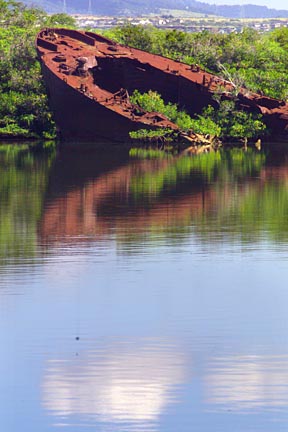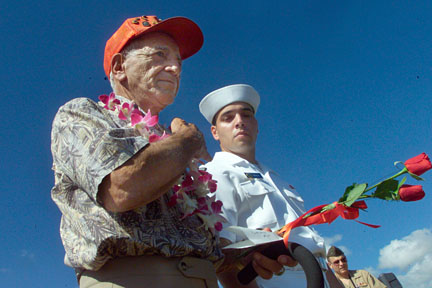
The rusting bow of LST 480 was left at Hanaloa Point in Pearl Harbor as a reminder of a disaster at West Loch that occurred on May 21, 1944.
Honoring the fallen
Survivors mark 60 years since
a World War II disaster
at Pearl Harbor
Seaman 1st Class Alex Bernal was on duty in West Loch ferrying sailors from a fleet of 29 Navy landing ships that had stopped at Pearl Harbor in 1944 for supplies in preparation for the invasion of Saipan.
Without warning, a munitions explosion on one of the landing ships set off a chain reaction that killed 163 men and wounded 396 during the May 21, 1944, incident, which was a Navy secret until 1960.
Yesterday, nine survivors of what has been described as the country's second Pearl Harbor observed the 60th anniversary of the disaster at the West Loch Naval Magazine. They each honored their fallen shipmates and Marines at the end of the 30-minute ceremony by tossing two long-stemmed red roses into the harbor.
The only reminder of the disaster is the rusting bow of LST 480, partially overgrown by weeds in shallow waters just off the Waipio Peninsula.
LSTs were 328-foot vessels designed to sail to the site of amphibious operations carrying equipment, cargo and troops. LST crews off-loaded troops and supporting equipment by beaching the ship directly onto the beachhead.
Walter Slater, 78, was a seaman 1st class on the 120-foot smaller landing craft (LCT 982), which was part of the cargo being carried by the larger LST 274. His LST was part of a nest of eight vessels that were moored together in West Loch's Walker Bay. There were five nests -- ranging from five to eight LSTs tied up side-by-side -- at the West Loch Naval Ammunition Depot.
Slater's poker game ended abruptly at 3:22 p.m. when the first explosion occurred. The card players ran to LST 274 below them.
"I was on the deck of LST 274 when a second explosion went off," Slater recalled after yesterday's ceremony. "It created a huge large cloud and balls of fire. The concussion would cause the cloud to mushroom outwards, and then shrapnel and other debris would come down on us."
Ship's Cook 2nd Class Roy Sannella made the sign of the cross yesterday prior to throwing in two long-stemmed roses during a ceremony commemorating 60 years since the disaster at Pearl Harbor.
Slater and another sailor picked up a bleeding shipmate and had to cross over several LSTs before they were able to lower the injured sailor into the water and swim to nearby Waipio Peninsula. On the beach they were struck by shrapnel from another explosion. Slater said the injured sailor died.
Bernal, 79, and Ship's Cook 2nd Class Roy Sannella, 79, rescued several men from the burning waters.
Rear Adm. Michael Roesner, Pacific Fleet deputy chief of staff, said the secrecy that surrounded the 1944 disaster was to prevent disclosure of the Saipan invasion.
"Just because not many people know, it does not trivialize the sacrifices that were made," Roesner said in his address. "These men were preparing for war. They were serving their country, and they sacrificed their lives with as much honor as the men who died on the battlefield."
A pier exhibit prepared by U.S. Park Service historian Daniel Martinez said the 29 LSTs were part of more than 100 vessels belonging to "Operation Forager" -- the invasion of Saipan and Guam. The invasion force included sailors, Army soldiers, Coast Guard men, and Marines from the 2nd and 4th Divisions.
The initial explosion is believed to have taken place on LST 353 and was either caused by gasoline vapors or one or more mortar shells exploding while being handled. Reddish flames and thick black smoke covered the harbor.
"The blast could be heard as far away as 15 miles," Martinez said.
But the invasion of Saipan was delayed for only a day.
Slater said the skipper of LST 274 was able to get under way and run the vessel up on a nearby beach.
"After patching a hole in the hull, we left Pearl Harbor two days later for the Marshall Islands and made the invasion of Saipan on June 15, 1944."

